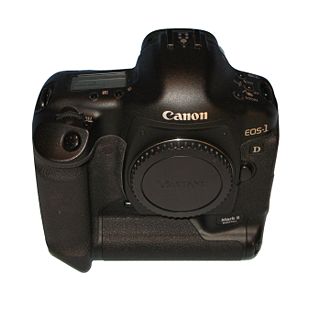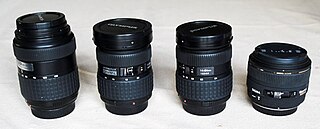
A digital camera is a camera that captures photographs in digital memory. Most cameras produced today are digital, largely replacing those that capture images on photographic film. Digital cameras are now widely incorporated into mobile devices like smartphones with the same or more capabilities and features of dedicated cameras. While there are still dedicated digital cameras, many more cameras are now incorporated into mobile devices like smartphones. High-end, high-definition dedicated cameras are still commonly used by professionals and those who desire to take higher-quality photographs.
The Foveon X3 sensor is a digital camera image sensor designed by Foveon, Inc., and manufactured by Dongbu Electronics. It uses an array of photosites that consist of three vertically stacked photodiodes. Each of the three stacked photodiodes has a different spectral sensitivity, allowing it to respond differently to different wavelengths. The signals from the three photodiodes are then processed as additive color data that are transformed to a standard RGB color space.

A digital single-lens reflex camera is a digital camera that combines the optics and the mechanisms of a single-lens reflex camera with a digital imaging sensor.

Sigma Corporation is a Japanese company, manufacturing cameras, lenses, flashes and other photographic accessories. All Sigma products are produced in the company's own Aizu factory in Bandai, Fukushima, Japan. Although Sigma produces several camera models, the company is best known for producing high-quality lenses and other accessories that are compatible with the cameras produced by other companies.
The Kodak Professional DCS Pro SLR/n is a 13.5 megapixel full-frame 35mm digital SLR produced as a collaboration between Nikon Corporation and Eastman Kodak. It was an improved version of the Kodak Professional DCS Pro 14n series, and was based on a modified Nikon N80 film SLR and thus compatible with almost all Nikon F mount lenses. The camera was announced in early 2004 and became available to purchase mid-year. A monochrome variant named Kodak Professional DCS Pro SLR/n m of the camera existed as well.

The Sigma SD10 is a digital single-lens reflex camera (DSLR) manufactured by the Sigma Corporation of Japan. It was announced on October 27, 2003, and is an evolution of the previous SD9 model, addressing many of the shortcomings of that camera. The Sigma SD10 cameras are unique in the digital DSLR field in using full-color sensor technology, and in that they only produce raw format images that require post-processing on a computer.

The EOS-1Ds Mark II is a digital SLR camera body introduced by Canon Inc. in 2004. It was the top model in the Canon EOS line of digital cameras until April 2007, with a full-frame 16.7 megapixel CMOS sensor. The EOS-1Ds Mark II had the highest pixel count available in a 35mm format digital SLR at the time of its introduction until its successor was announced in August 2007. It uses the EF lens mount. The EOS-1Ds Mark II is a professional grade camera body and is large, ruggedly built, and dust/weather-resistant.

The EOS-1Ds is a full-frame 11.1-megapixel digital SLR camera body made by Canon in the 1Ds series, released on 24 September 2002. It was Canon's first full-frame DSLR. Its dimensions are 156 x 157.6 x 79.9 mm and mass is 1,265 g.

The EOS 1D Mark II is a professional 8.2 megapixel digital single lens reflex camera (DSLR) camera body produced by Canon. The EOS 1D Mark II was the successor of the EOS 1D and was itself replaced by the Canon EOS-1D Mark III in 2007. It was Canon's first dual-card slot EOS camera with one CF slot and one SD slot that was meant easily to use two dominant card types and have a assurance that once a small sized primary and faster CF slot is full, camera can be used to take photographs when recording was continued on secondary and slower card in critical moment. It also now had wireless capabilities. When paired with the new Canon WFT-E1, you could transfer images to a PC using an FTP server.

Advanced Photo System type-C (APS-C) is an image sensor format approximately equivalent in size to the Advanced Photo System film negative in its C ("Classic") format, of 25.1×16.7 mm, an aspect ratio of 3:2 and Ø 31.15 mm field diameter. It is therefore also equivalent in size to the Super 35 motion picture film format, which has the dimensions of 24.89 mm × 18.66 mm and Ø 31.11 mm field diameter.

The Sigma SD9 is a digital single-lens reflex camera (DSLR) produced by the Sigma Corporation of Japan. The camera was launched at the Photo Marketing Association Annual Show on February 18, 2002. It was Sigma's first digital camera, and was the first production camera to use the unique Foveon X3 image sensor, which reads full color at each pixel site. Other sensors detect only one color at each site and interpolate to produce a full-color image.

A full-frame DSLR is a digital single-lens reflex camera (DSLR) with a 35mm image sensor format. Historically, 35mm was considered a small film format compared with medium format, large format and even larger.
The Sigma SA-mount is a lens mount by the Sigma Corporation of Japan for use on their autofocus single-lens reflex and mirrorless cameras. It was introduced with the SA-300 in 1992. Originally, the SA-mount was a dual-bayonet mount with inner (SA-IB) and outer (SA-OB) bayonets, the latter being a feature intended to mount heavy telephoto lenses, but never utilized by Sigma and consequently dropped with the release of the SD14 in 2007.

In digital photography, the image sensor format is the shape and size of the image sensor.

This article is about photographic lenses for single-lens reflex film cameras (SLRs) and digital single-lens reflex cameras (DSLRs). Emphasis is on modern lenses for 35 mm film SLRs and for DSLRs with sensor sizes less than or equal to 35 mm ("full-frame").

The Kodak Digital Camera System is a series of digital single-lens reflex cameras and digital camera backs that were released by Kodak in the 1990s and 2000s, and discontinued in 2005. They are all based on existing 35mm film SLRs from Nikon, Canon and Sigma. The range includes the original Kodak DCS, the first commercially available digital SLR.

A mirrorless camera is a photo camera featuring a single, removable lens and a digital display. The camera does not have a reflex mirror or optical viewfinder like a digital single-lens reflex (DSLR) camera, but may have an electronic viewfinder. Many mirrorless cameras retain a mechanical shutter. Like a DSLR, a mirrorless camera accepts any of a series of interchangeable lenses compatible with its lens mount.

The Canon EOS 60D is an 18.1 megapixels semi-pro digital single-lens reflex camera made by Canon. It was announced on August 26, 2010, with a suggested retail price of US$1099.00. As a part of the Canon EOS two-digit line, it is the successor of the EOS 50D and is the predecessor of the EOS 70D.

The EOS-1Ds is a series of full-frame digital SLR camera bodies made by Canon, first released on 24 September 2002. The series was replaced in March 2012 with the 1D X.

The Fujifilm FinePix HS50EXR is a DSLR styled ultra-zoom bridge camera announced by Fujifilm on January 7, 2013. It is the last model of the Fujifilm FinePix HS series. At the time of its release, it competed most closely with the Canon PowerShot SX50 HS, another ultra-zoom bridge camera with raw capability. The SX50 has 20% longer maximum effective focal length, but the HS50 has 33% more resolution on the sensor.


















